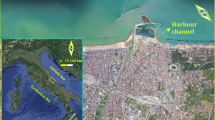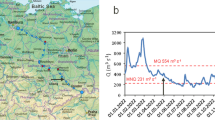Abstract
Tidal rivers are intrinsically complex because tidal propagation is influenced by river discharge. This study aims to examine the seasonal variation of tidal prism and energy variance in the tidal river of the Changjiang (Yangtze) River estuary in China. In order to quantify the behaviour of river and tide, we use numerical modelling that has been validated using measured data. We conduct our analysis by quantifying the discharge and energy variance in separate components for both the river and the tide, during wet and dry seasons. We note various definitions of tidal prism and explore the difference between tidal discharge on the flood and ebb and tidal storage volume. The results show that the river discharge attenuates the tidal motion and reduces the tidal flood discharge but the tidal storage volume is approximately constant with different riverine discharge since part of the fresh water discharge is intercepted and captured in the estuary due to the backwater effect. It appears that the tidal discharge adjusts according to the variation of river discharge to keep a constant tidal storage volume. An analysis of the hydraulics shows that the transition from tidal dominance (at the mouth) to river dominance (upstream) depends on the location of tidal current reversal which varies from wet season to dry season. Duringthe wet season, the Changjiang River estuary is totally dominated by energy from fresh water discharge.
Similar content being viewed by others
References
Cai H, Savenije H H G, Toffolon M. 2014. Linking the river to the estuary: influence of river discharge on tidal damping. Hydrol. Earth Syst. Sci., 18: 287–304.
Canestrelli A, Lanzoni S, Fagherazzi S. 2014. One-dimensional numerical modeling of the long-term morphodynamic evolution of a tidally-dominated estuary: the lower fly river (Papua New Guinea). Sediment. Geol., 301: 107–119.
Chen M S, Wartel S, Van Eck B, Van Maldegem D. 2005. Suspended matter in the Scheldt estuary. Hydrobiologia, 540 (1-3): 79–104.
Dalrymple R W, Choi K. 2007. Morphologic and facies trends through the fluvial-marine transition in tide-dominated depositional systems: a schematic framework for environmental and sequence-stratigraphic interpretation. Earth -Sci. Rev., 81 (3-4): 135–174.
Davies G, Woodroffe C D. 2010. Tidal estuary width convergence: theory and form in North Australian estuaries. Earth Surf. Proc. Land., 35 (7): 737–749.
Davies J L. 1964. A morphogenic approach to world shorelines. Z. Geomorphol., 127 (8): 42.
Davis R A Jr, Fitzgerald D M. 2004. Beaches and Coasts. Blackwell Publishing, Oxford.
Ensign S H, Doyle M W, Piehler M F. 2013. The effect of tide on the hydrology and morphology of a freshwater river. Earth Surf. Proc. Land., 38 (6): 655–660.
Ge J Z, Chen C S, Qi J H, Ding P X, Beardsley R C. 2010. A dike-groyne algorithm in a terrain-following coordinate ocean model (FVCOM): development, validation and application. Ocean Modelling, 47: 26–40.
Godin G. 1999. The propagation of tides up rivers with special considerations on the upper saint lawrence river. Estuarine, Coastal and Shelf Science, 48 (3): 307–324.
Gong Z, Zhang C K, Wan L M, Zuo J C. 2012. Tidal level response to sea-level rise in the Yangtze estuary. China Ocean Eng., 26 (1): 109–122.
Guo L, Van Der Wegen M, Roelvink J A, He Q. 2014. The role of river flow and tidal asymmetry on 1-D estuarine morphodynamics. Journal of Geophysical Research: Earth Surface, 119 (11): 2 315–2 334.
Hervouet J M. 2007. Hydrodynamics of Free Surface Flows: Modelling with the Finite Element Method. John Wiley & Sons, New York.
Hume T M, Herdendorf C E. 1993. On the use of empirical stability relationships for characterising estuaries. J. Coastal Res., 9 (2): 413–422.
Hume T M. 2005. Tidal prism. In: Schwartz M L ed. Encyclopedia of Coastal Science. Springer, Netherlands. p.981–982.
Johnson R S. 1997. A Modern Introduction to the Mathematical Theory of Water Waves. Cambridge University Press, Cambridge.
Langbein W B. 1963. The hydraulic geometry of a shallow estuary. International Association of Scientific Hydrology. Bulletin, 8 (3): 84–94.
Luketina D. 1998. Simple tidal prism models revisited. Estuarine, Coastal and Shelf Science, 46 (1): 77–84.
O’Brien M P. 1931. Estuary tidal prisms related to entrance areas. Civil Eng., 1 (8): 738–739.
Pethick J. 1984. An Introduction to Coastal Geomorphology. Edward Arnold Publ, London, UK.
Phillips J D, Slattery M C. 2007. Downstream trends in discharge, slope, and stream power in a lower coastal plain river. Journal of Hydrology, 334 (1-2): 290–303.
Richards K. 1982. Rivers: Form and Process in Alluvial Channels. Methuen & Co Ltd, London.
Sassi M G, Hoitink A J F. 2013. River flow controls on tides and tide-mean water level profiles in a tidal freshwater river. Journal of Geophysical Research: Oceans, 118 (9): 4 139–4 151.
Sassi M G, Hoitink A J F, De Brye B, Deleersnijder E. 2012. Downstream hydraulic geometry of a tidally influenced river delta. Journal of Geophysical Research F: Earth Surface, 117 (F4): F04022.
Savenije H H G. 2012. Salinity and Tides in Alluvial Estuaries. 2 nd edn. Elsevier Science, New York.
Toffolon M, Todeschini I, Tubino M. 2005. Long-term evolution of self-formed estuarine channels. In: Parker G, García M eds. River, Coastal and Estuarine Morphodynamics: RCEM 2005. Taylor & Francis Group, London.
Townend I, Dun R. 2000. A diagnostic tool to study long-term changes in estuary morphology. Geol. Soc. Spec. Publ., 175: 75–86.
Townend I. 2005. An examination of empirical stability relationships for UK Estuaries. J. Coastal Res., 21 (5): 1 042–1 053.
Van Der Wegen M, Wang Z B, Savenije H H G, Roelvink J A. 2008. Long-term morphodynamic evolution and energy dissipation in a coastal plain, tidal embayment. @, 113 (F3): F3001.
Wu H L, Shen H T, Wu J X. 2002. Relationships among depth datum levels in the Yangtze Estuary. The Ocean Engineering, 20 (1): 69–74. (in Chinese with English abstract)
Xia Y F, Cao M X, Chen X B. 2001. Formation analysis and regulation plan for dredging channel of the three sand shoals (Fujiang sand shoal, Tongzhou sand shoal and Baimao sand shoal) on the Lower Yangtze River. Journal of Sediment Research, (3): 57–61. (in Chinese with English abstract)
Xu K, Chen Z Y, Zhao Y W et al. 2005. Simulated sediment flux during 1998 big-flood of the Yangtze (Changjiang) River, China. J. Hydrol., 313 (3-4): 221–233.
Xu K, Milliman J D. 2009. Seasonal variations of sediment discharge from the Yangtze River before and after impoundment of the Three Gorges Dam. Geomorphology, 104 (3-4): 276–283.
Yang C T. 1971. Potential energy and stream morphology. Water Resour. Res., 7 (2): 311–322.
Yang C T, Song C C S, Woldenberg M J. 1981. Hydraulic geometry and minimum rate of energy dissipation. Water Resour. Res., 17 (4): 1 018–1 041.
Yu F L, Chen Z Y, Ren X Y, Yang G F. 2009. Analysis of historical floods on the Yangtze River, China: characteristics and explanations. Geomorphology, 113 (3-4): 210–216.
Zhang E F, Savenije H H G, Chen S L, Mao X H. 2012. An analytical solution for tidal propagation in the Yangtze Estuary, China. Hydrol. Earth Syst. Sc i., 16 (9): 3 327–3 339.
Zhang M et al. 2013. Shallow Shoals on Lower Changjiang River analysis using landsat archive. In: The Sixteenth China Ocean (Coast) Engineering Symposium. Beijing. p.1 331–1 337. (in Chinese with English abstract)
Author information
Authors and Affiliations
Corresponding author
Additional information
Supported by the National Basic Research Program of China (973 Program) (No. 2010CB951204), the National Natural Science Foundation of China (No. 44107180), and the 111 Project (No. B08022)
Rights and permissions
About this article
Cite this article
Zhang, M., Townend, I.H., Cai, H. et al. Seasonal variation of tidal prism and energy in the Changjiang River estuary: a numerical study. Chin. J. Ocean. Limnol. 34, 219–230 (2016). https://doi.org/10.1007/s00343-015-4302-8
Received:
Accepted:
Published:
Issue Date:
DOI: https://doi.org/10.1007/s00343-015-4302-8




